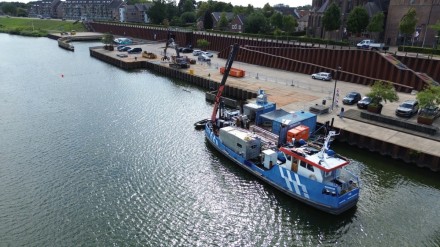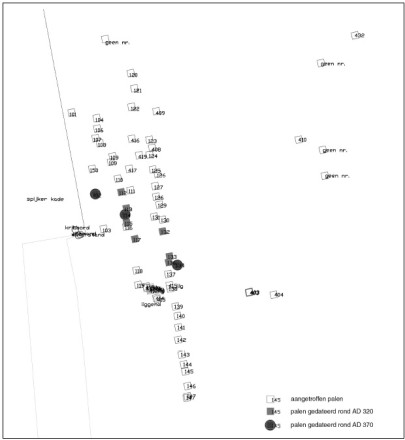History
From “Preserve in situ to Rescue Operation
Originally, the Dutch Cultural Heritage Agency had planned to preserve the quay remains in situ, under protective sediment. But since 2006, increased river traffic and propeller wash have accelerated erosion. Sediment cover no longer shielded the timbers, and each passing year risked irreversible damage.

Faced with this threat, authorities approved a full-scale recovery project—an ex situ preservation effort—so that the timbers and artifacts could be studied and conserved before being lost. The decision reflects a growing national strategy on how to deal with underwater heritage in dynamic river systems, formalized in June 2025.
Cutting-Edge Underwater Archaeology
The excavation itself showcases the precision of modern underwater archaeology. Divers first mapped the extent of the site with boreholes and geophysical surveys. Once recorded, protective sediments were carefully removed. Using specialized suction equipment—often described as an “underwater vacuum”—archaeologists extracted layers of material without disturbing fragile remains. Each timber was documented, measured, and lifted to the surface for detailed analysis on deck.
The project is led by a consortium of Vestigia, Baars-CIPRO, and MSDS Marine, in partnership with the diving collective Mergor in Mosam, whose sport divers had monitored the site for years. Volunteers play a key role, assisting professionals in both surveying and recovery, highlighting how citizen science supports national heritage management.
This site offers us a unique chance to study late Roman infrastructure where military presence, trade, and daily life converged,” the excavation team explained. “Few harbor-like complexes from this period are known in the Netherlands, making Cuijk a crucial discovery.
Roman quay remains
In 1993 heavy wooden piles were found at the riverside of the Meuse, at Cuijk, known as Area 6000. These foundation piles are interpreted as part of a Roman quay, related to the Roman bridge (found in 1989), and the Late Roman castellum of Ceuclum, researched in several campaigns between 1937 and 1966.
During archaeological research in the centre of Cuijk, between 1937 and 1966, traces of a Roman presence were found. The nature of the remains is not clear, but there has been Roman occupation from at least 50 AD. The Roman site was probably in use until 100 AD. For the following 200 years, the Early Roman site was in use as a vicus. It was a regional centre, and a discovered Roman temple suggests religious importance. In the 4th century, under Constantine I (306-337 AD), a wooden castellum was built in more or less the same place as the Early Roman site. Under Valentinian I (364-375 AD) the castellum was rebuilt.
Archaeological research on the Roman quay
Since the discovery of the quay in 1993, 35 metres upstream from the Roman bridge, a total of 149 square cut piles have been discovered, with a layer of organic material in between. During a research campaign in 2009, 15 piles were, by accident, recovered and were later dated by dendrochronology. The piles are of oak wood and originate from the northern basin of the Meuse, possibly near Gennep, similar to the wood used for the Roman bridge. Of these piles, 120 piles were found in situ, vertically in the ground, and they have been identified as foundation piles. Of 28 piles, found horizontally, it was unclear whether they were used as foundation piles or as construction beams. Only one of the piles can be identified as a construction beam, due to the traces of modification on both sides. The recovered piles had a length of between 100 and 300 centimetres. None of the piles shows signs of pile shoes.

Dating
Several beams have been dated dendrochronologically. Four beams were sampled during the early research in the 1990s and provided dates of 309, 321, 358 and 373 AD. The piles recovered in 2009 were also dated by dendrochronology and gave two phases of tree felling, being 325-326 AD and 372-373 AD. The earlier dated piles roughly fit into these phases.
The layer of organic material consisted of a 70-centimetre thick peat-like material, with numerous finds from Roman times, like Roman pottery, leather, bones, glass, ash, coins, beads and building material. The organic material consisted primarily of wood chippings, sand, plant residue, gravel, charcoal and twigs. Two samples of the peat-like material gave a 14C dating of 130-330 AD and a piece of charcoal from the same layer gave the same date after 14C analysis. Roman pottery has a wide dating range from 50 AD until the first quarter of the 4th century.
The Roman authority probably left Ceuclum in the first quarter of the 5th century, probably in 406, after the Barbarian attacks from the south.

Description
The Roman quay at Cuijk was a wooden quay, resting on heavy wooden foundation beams. It was located on the riverside of the Meuse at a close distance from the Roman bridge and the Late Roman castellum, at Cuijk.

Status
Area 6000 is a site of high archaeological value and is partly a protected archaeological monument (Monument number: 524076). In 2006 the monument was covered for protection, with a layer of geotextile, a layer of clay and a top layer of polypropylene netting and galvanized wire netting, secured with stakes and sandbags. A year later a ship heavily damaged the top layer of the covering. Due to the propelling force of ships, the protective cover has been heavily damaged. The stakes are pulled out of the ground, the layer of geotextile is torn loose and partly missing and the layer of clay is almost entirely gone. The stratigraphy of the site is most likely disturbed by the ship propellers and mixed with the layer of recent clay.

Assessment & research 2013
From the 28 August 2013 until 7 September 2013 an assessment research project was undertaken by the Maritime Program of the Cultural Heritage Agency of the Netherlands. Plans of the municipality of Cuijk to renovate the modern quay will have a big influence on the remains of the Roman quay. The assessment research needs to determine whether the sheet pile walls can be driven into the riverbed without damaging the archaeological remains, or if an archaeological excavation is needed. Several dives showed most of the piles are not covered by the netting anymore and have been splintered on the top or have been moved due to collisions with ships. The site is, in the condition, it is in now, no longer protected and is now vulnerable to outside influences. To investigate the status of the monument, the protective layer has to be removed. The Cultural Heritage Agency of the Netherlands recommends a small excavation to secure the missing information of the site before the site deteriorates any further.

References
- Brinkkemper O., W.F.G.J. Brouwers, T. Coenen, J.W. de Kort & J. Opdebeeck (2016).
Gebied 6000: Duikonderzoek naar de Romeinse loskade bij Cuijk.
RCE, RAM 229. - Bogaers, J.E (1966).
Opgravingen te Cuijk, 1964-1966.
Nieuwsbulletin van de Koninklijke Nederlandse oudheidkundige Bond, 1966, 7e Aflevering, Voorburg.
pp 65-72. - Bogaers, J.E. (1967).
Some notes in connection with the Dutch section of the Limes of Germania Inferior (Germania Secund).
in M. Gichon (ed.), Roman Frontier Studies, Tel Aviv.
pp 71-87. - Seinen, P.A./J. A. van den Besselaar (2014).
A Late Roman Quay in the River Meuse near Cuijk, Netherlands.
International Journal of Nautical Archaeology, 43-2. - Seinen, P.A./J.A. van den Besselaar (2016).
Een laat-Romeinse steiger in de Maas bij Cuijk.
Westerheem 2016-1. - Thijssen, J. (2011).
Laat-Romeins aardewerk uit de Maas bij Cuijk.
Westerheem 2011-8. - Driel-Murray, Carol van (2007).
Mode in de nadagen van het Keizerrijk: de schoenen van Cuijk.
Westerheem 2007-3.